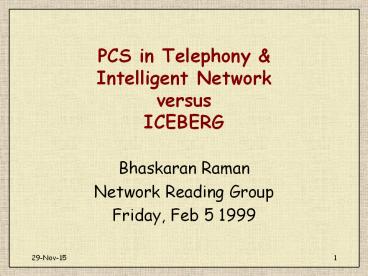PCS in Telephony - PowerPoint PPT Presentation
Title: PCS in Telephony
1
PCS in Telephony Intelligent NetworkversusICEB
ERG
- Bhaskaran Raman
- Network Reading Group
- Friday, Feb 5 1999
2
Outline
- Personal Communication Services (PCS) in
telephony - IN architecture (very high level)
- Relation to ICEBERG
3
Personal Communication Services
4
What is PCS?
- Vague term - not well defined
- Personalised voice, data, image, video
- Three types of mobility
- Terminal mobility (network level)
- Personal mobility (across access devices and
networks) - Service mobility (see the same personal service
profile)
5
What is PCS?
- PCS also talks about customization security
- From telephone network background
- service providers and subscribers
- trusted network
- dumb end-points
- Interworking is required between service providers
6
The Networks
- Fixed Networks (POTS)
- Cellular (e.g. GSM)
- Digital Cordless (e.g. DECT)
- Wireless data (e.g. GPRS)
- Satellite
7
PCS in Fixed Networks
- Call Screening
- Personal Numbering (Hotline)
- Profile Management
- Call Forwarding
- Automatic Callback
8
UPT
- Subscriber has personal number
- Billing and service profiles based on the
personal number - Service availability across different (fixed)
networks
9
GSM
- Does not provide full PCS
- Handles terminal mobility well
- No complete integration with cordless
- SIM provides another kind of mobility
10
UMTS, IMT2000, FPLMTS
- Networks to provide PCS
- UMTS - ETSI effort
- IMT2000 (previously FPLMTS) - ITU effort
- To provide global mobility digital data services
11
IN Architecture
12
What is IN?
- Separation of spec, creation control of
services from physical switching networks - Evolved from a world where the only service
available was switching - Present from day 1 in IP
13
AIN History
- Idea of Stored Program Control
- for ease of deploying services
- IN/1 - 800 calling, call waiting
- IN/2 - additional services
- IN/1 - simplification of IN/2
- MVI (Multi-Vendor Interactions)
- AIN
14
What does it define?
- Technical capabilities for SS7 components
- SCP (Service Control Point)
- SSP (Service Switching Point)
- IP (Intelligent Peripheral)
- Planes of abstraction
15
TCP/IP
- IN defines Points-In-Call (PICs) at SSPs
- off-hook
- digit-called
- did not answer...
- TCP (Trigger Check Point) for each PIC
- FE (Functional Entity) at SCP/IP
16
An Example AIN Service
- Portable Speed Calling List
- Dial 55, PIN, Speed Calling Number
- How is it speedy ?
- AIN switch causes a trigger
- Sends message to SCP
17
Example Service Continued...
- SCP invokes SLP (Stored Logic Program)
- SCP verified PIN
- Completes call
18
Feature Interaction
- How do complicated features have unforeseen
interactions? - Examples
- Universal Call Forwarding paying toll
- Voice mail sign???
- OCP, TCP, CFU
19
ICEBERG
- In addition to PCS
- Network transparency across voice/data/paging
networks - Service transformations (e.g. E911)
- Service handoff
- User preference management (Universal Inbox)
- Any-to-Any data transformations
20
ICEBERG
- Anyone can deploy services (flexible service
infrastructure) - Motivation for IN
- rapidly engineer new revenue producing
services, in response to market
opportunities.Ultimately, service creation, or
at least service customization can be extended to
subscribers
21
Discussion
- Why did they hack away?
- SS7, UPT, IN -- are they still hacks?
- Billing and security aspects are studied in
standardization bodies (ETSI and ITU), but work
on these subjects is not very advanced because of
the complexity involved for network operators to
protect their interests































